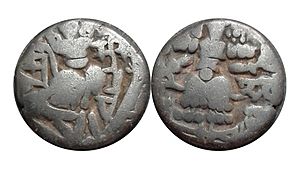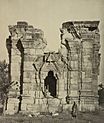Sugandha facts for kids
Quick facts for kids Sugandha |
|
|---|---|
| Sri Sugandha Deva | |

Coinage of Queen Sugandha. 'Sri Sugandha Deva' is written in Sharada script.
|
|
| Queen of Kashmir | |
| Reign | 904 – 906 |
| Predecessor | Sankata |
| Successor | Partha |
| Pretender to the throne of Kashmir | |
| Pretendence | 906 – 914 |
| Queen Regent of Kashmir | |
| Tenure | 902 – 904 |
| Monarch | Gopalavarman |
| Queen Consort of Kashmir | |
| Tenure | 883 – 902 |
| Monarch | Sankaravarman |
| Died | 914 CE Nispalaka Vihara |
| Spouse | Sankaravarman |
| Issue | Gopalavarman |
| House | Utpala dynasty |
| Father | Svamiraja |
| Religion | Hinduism |
Sugandha (fl. 883 – 914) was the ruler of Kashmir in the northern Indian subcontinent during the 10th century. She was married to Sankaravarman, the King of Kashmir, and was Queen Consort of Kashmir from 885 CE to Sankaravarman's death in 902 CE, when she became Queen Regent for her son, Gopalavarman, until 904 when all successors to the throne has died so she was declared Sri Sugandha Deva, Queen of Kashmir. She was dethroned by the Tantrins in 906 and they installed Partha as monarch. Sugandha continued to claim the throne of Kashmir and retreated to live in Haskapura (present-day Ushkur, Baramulla). In 914 she went to war against Partha and the Tantrins, but was imprisoned and later killed in a Buddhist monastery called Nispalaka Vihara.
Early life and marriage
Sugandha was the daughter of Svamiraja, the king of a kingdom near Kashmir and he had at-least three other queens including one Surendravati. Sugandha was married to Sankaravarman, who reigned as King of Kashmir from 885 CE until 902 CE. During this time, Sugangha acted as his consort. Sankaravarman died in 902 of a stray-arrow at Urusha (present-day Hazara, Pakistan), whilst returning from a not-so-successful conquest, where Sugandha had also accompanied him. Following his death, he was succeeded by his son, Gopalavarman. While some of Sankaravarman's queens and servants died by Sati, the Dowager Queen Sugandha refused it so as to act as Queen Mother and regent for Gopalavarman. After Sankaravarman's last rites had finished, Gopalavarman was crowned the King of Kashmir.
Although Sugandha was good at managing the affars of the kingdom, she took pleasure in bodily indulgences. Various historians accuse her of being intimate to her treasury minister Prabhakaradeva, who they describe as her paramour. Prabhakaradeva used to exercise the real powers of the King. He engaged in prolonged theft of state-treasures and was finally probed by Gopalavarman. In due course, Prabhakaradeva employed a relative Ramadeva to assassinate the king by practice of witchcraft. Gopalavarman died of a fever and Ramadeva died after his conspiracy became public knowledge.
After Gopalavarman's death, his brother Sankata became King but he died mysteriously after ten days. After Sankaravarman's lineage died out, Kashmir fell into a political turmoil. Courtiers started plotting a coup and public figures called a Maha-Panchayat to choose the kingdom's ruler. As Sugandha was quite popular among the people, she was proclaimed the sovereign of Kashmir.
Reign
In 904 CE, Sugandha assumed royal power and ruled Kashmir in her own right. Some historians believe that she did it apparently with an intention of securing it for her grandson — the yet-unborn child of Jayalakshmi. She ruled Kashmir for two years (r. 904 – 906).
She hoped that she would be succeeded by her unborn grandson, the son of Gopalavarman but Jayalakshmi's pregnancy resulted in a stillbirth. Sugandha, now in despair, wished that she be succeeded by one of her blood-relatives, Nirjitavarman, a grandson of Suravarman and a half-brother of Avantivarman, nicknamed "Pangu" (lame). She nominated Pangu to the throne and in doing this, she had to seek the advice and permission of her ministers. Sugandha's choice was met with considerable resistance from the ministers as well as the Tantrins, on grounds of Nirjitavarman's lameness. Sugandha was dethroned by the Tantrins and they installed Nirjitavarman's ten-year-old son Partha as monarch instead. Following her dethronement in 906 CE, Sugandha continued to claim the throne of Kashmir and retreated to live in Haskapura (present-day Ushkur, Baramulla).
Imprisonment and death
In 914, after eight years of exile in Haskapura, Sugandha was persuaded by the Ekangas, Royal bodyguards and other factions loyal to her, to wage a war against Partha and the Tantrins. The fierce battle occurred in the suburbs of Srinagar in April 914 CE. She was defeated and captured by the Tantrins. Sugandha was imprisoned and later killed in a Buddhist monastery called Nispalaka Vihara. Kalhana observes: "Strange are the ways of fate, ever falling and rising".
Legacy
Some historians call her reign as the "golden age" of Kashmir. Historian Premnath Bazaz states that "She was loved by the people, trusted by the courtiers, and admired by the army".
Sugandha's reign constitutes the first concrete and historically verifiable reign of a female sovereign in Kashmir's history and ruled at the behest of her subjects.
During her reign, Sugandha built the towns of Sugandhapura and Gopalapura, the Vishnu temple Gopalakesava, and the monastery of Gopalamatha. She also built the Sugandesha Temple, located at Pattan, which has a square sanctum with a portico in front and a peristyle around.
Sankaravarman, along with Sugandha, dedicated two temples to Mahadeva, namely Sankara Gauresa and Sugandhesvara at the new capital of Sankarapura. These two stately temples are still standing today at modern-day Pattan.
Sugandha's coinage is an important corroborative evidence of her power and refers to her by the masculine epithet, Sri Sugandha Deva. Ardochsho (Goddess Lakshmi) is seen seated in Lalitasana in most of the coins and Sharda script is distinctly visible.
Ekangas and Tantrins
In early medieval Kashmir, the rule of the Utpala dynasty in the Vale of Kashmir was dominated by the rivalry of two military factions, the Tantrins and the Ekangas. Their vying led to the installment of new monarchs and dethronement of others. Tantrins were a strong military class organisation. Tantrin foot-soldiers had formed a confederacy and were strong enough to punish or to favour the rulers of the kingdom. Ekangas are said to have been Royal bodyguards, who influenced the affairs of the court and the state. After Sugandha was defeated in 914 CE, and none of the succeeding rulers was able to assert their supremacy over the Tantrins.
Finally, feudal landowners, known as damaras, were called put an end to the power struggle. They successfully destroyed the power of the Tantrins, after which the rulers of Kashmir were faced with the new problems of curbing the power of the landowners, as is evident from political events during the rule of Queen Didda.
Timeline




